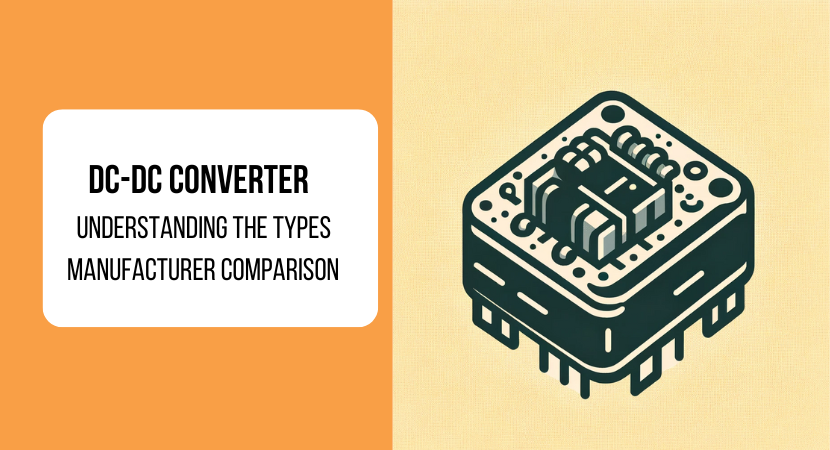There are several types of DC-DC converters, each with different characteristics, so please be sure to choose the one that best suits the product you are considering. Reading this article can help you choose the converter that provides the best performance suited to your needs.
In this article, we will explain the design principles and types of DC-DC converters, how to use them properly, the characteristics of each converter, comparisons with other circuit components, and criteria for selection, along with manufacturer information.
We hope that after reading this post, you will have a better understanding of the selection criteria for DC-DC converters. We have also recommended companies that manufacture DC-DC converters towards the end, so if you are interested in any of the listed companies, please contact us using the button.
目次
What is a DC-DC converter? Design principle and characteristics of four types
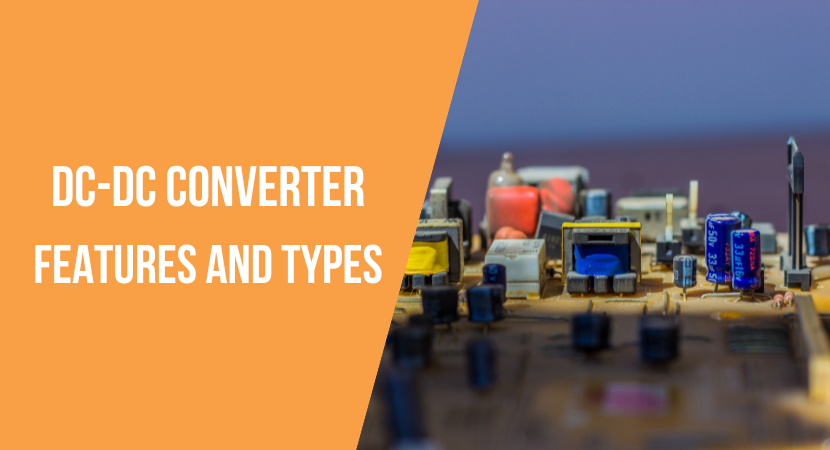
There are several types of converters, and a DC-DC converter is a device that converts one DC voltage to another DC voltage. DC-DC converters play an important role in providing adequate power to components that require various voltage levels in electronic equipment.
Two types of basic structures
DC-DC converters are basically divided into two types: isolated types and non-isolated types. The isolated type uses a transformer to electrically isolate the input and output, achieving a high step-up/down ratio and safety. The non-isolated type does not use a transformer, making it compact, low cost, and provides highly efficient power supply.There are various types of DC-DC converter circuit technology, depending on how voltage and current are controlled using passive components such as switching elements, inductors, and capacitors.
The table below summarizes the differences between isolated and non-isolated types.
| Summary | Usage | |
|---|---|---|
| Isolated DC-DC converter | Method of converting voltage while insulating input and output using a transformer | Isolation between input and output is possible, improves noise countermeasures and safety |
| Non-isolated DC-DC converter | Method of converting voltage without using a transformer |
Suitable when the circuit is compact and no insulation between input and output is required |
Isolated DC-DC converter
Typical isolated DC-DC converter circuits include flyback circuits, forward circuits, push-pull circuits, and half-bridge circuits. These circuits place a switching element (MOSFET, transistor, etc.) on the primary side of a transformer to generate a high-frequency pulse current.When this pulsed current flows through the primary winding of the transformer, a voltage is induced in the secondary winding of the transformer. This voltage is converted to direct current by a rectifying element (diode, MOSFET, etc.) and a smoothing capacitor, and becomes the output voltage.
Due to its characteristics, isolated DC-DC converters are often used in machines where safety and reliability are particularly important. For example, they are used in medical equipment (to ensure patient safety), control systems (sensor systems, etc.), and communication equipment (for noise isolation and safe power supply).
Non-isolated DC-DC converter
On the other hand, typical circuits of non-isolated DC-DC converters include buck circuit, boost circuit, buck-boost circuit, septic circuit, etc. These circuits use choke coils instead of transformers to step up and down the voltage. A choke coil has the property of generating voltage in response to changes in current.When the switching element is turned on, the input voltage is applied to the choke coil and current is stored in the choke coil. When the switching element is turned off, the current stored in the choke coil is released and converted to direct current by the rectifying element and smoothing capacitor, resulting in the output voltage.
Non-isolated DC-DC is used in a variety of machines due to its compactness, cost-effectiveness, and simple design. For example, they are used in common consumer electronic products such as portable music players, computer power supplies, and automobile navigation systems.
So far, we have introduced the basic mechanism and basic structure of a DC-DC converter. In the next chapter, we will introduce typical DC-DC converters in terms of their functional characteristics and basic information such as their overview and applications in a table.
After reading the basic information, you can gain a deeper understanding by reading the “Advantages, Disadvantages, and Different Uses of DC-DC Converters” below.
Two types of functional features
Apart from structural characteristics, DC-DC converters can also be considered from the perspective of differences in functional characteristics. Two typical examples are the linear regulator type and the switching regulator type.There are derivative types of each, such as the former being a dual tracking regulator and the latter being a resonant type, but these two are the basic types.
To put it simply, the difference between the two is that the voltage conversion method is different. Depending on whether you understand the relationship between the structure, functions, and features mentioned above, your level of understanding of the advantages and disadvantages of using it in your product will change. Here’s a summary of the table:
| Summary | Usage | |
|---|---|---|
| Linear Regulator type |
Method of lowering the required voltage from the input voltage using a resistor |
Suitable when the circuit is compact and no insulation between input and output is required |
| Switching Regulator type |
A method in which the input voltage is pulsed with a switching element and smoothed with an inductor or capacitor |
High conversion efficiency, independent of input/output voltage ratio |
Linear regulator type DC-DC converter
A linear regulator type refers to a method in which the required voltage is stepped down from the input voltage using a resistor.Other features include a compact circuit, making it suitable for use where isolation between input and output is not required.
Switching regulator type DC-DC converter
A switching regulator type refers to a method in which the input voltage is pulsed using a switching element and smoothed (eliminated by averaging processing to eliminate noise) using an inductor or capacitor.Another feature is that the conversion efficiency is high, so it can be used regardless of the input/output voltage ratio.
So far, we have explained the design principles, types, characteristics, and usage of DC-DC converters. The next chapter provides a comparison between DC-DC converters and other circuit components such as inductors.
Advantages and Disadvantages of DC-DC Converters
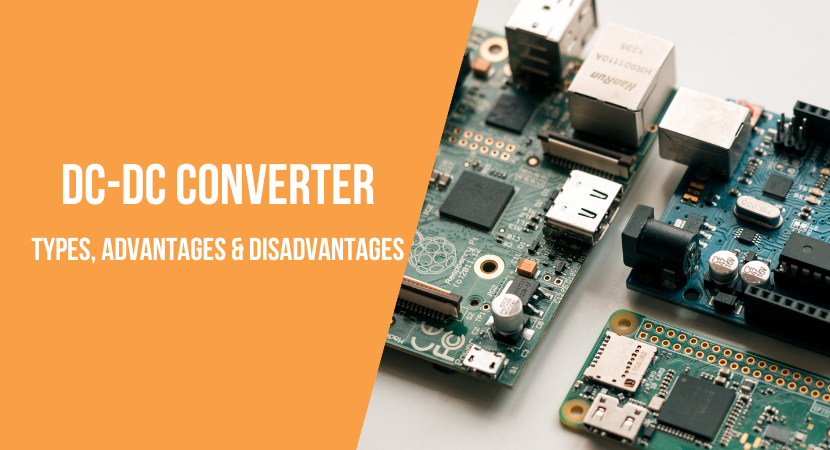
In the previous chapter, we explained the design principles, types, characteristics, and usage of DC-DC converters. Let us now take a closer look at the advantages and disadvantages of DC-DC converters in general by comparing them with many other circuit components such as inductors, capacitors, and ICs.
Advantages
There are three advantages to using a DC-DC converter:- Improved power efficiency
- Realization of smaller and lighter power supplies
- Achieving diversification and flexibility of power sources
Improving power efficiency
A DC-DC converter efficiently converts incoming power to the required voltage. This reduces energy loss and allows for longer usage times for battery-powered equipment, for example.Efficient power conversion also reduces heat generation and improves equipment safety. For example, data center servers consume a lot of power due to their high operating rates and processing large amounts of data, so DC-DC converters that can efficiently supply power are required.
Realization of smaller and lighter power supplies
Modern DC-DC converters are designed using advanced semiconductor technology and small components. Therefore, It is possible to produce a power supply unit that is much smaller and lighter than conventional ones, and as a result, the equipment itself can be made smaller and lighter.This is an especially important feature in portable devices and wearable technology. For example, lightweight and compact devices such as smartwatches and fitness trackers are important.
Realizing power source diversity and flexibility
DC-DC converters can operate stably with different input voltages and provide the required output voltage. This allows stable performance to be maintained even with a variety of input power supplies.It is also compatible with power supply standards in different countries and renewable energies such as solar power generation. In particular, automobiles and in-vehicle equipment often require such flexibility, as the voltage status of the vehicle changes depending on operating conditions.
Disadvantages
There are three main disadvantages to using a DC-DC converter: Understanding the disadvantages is important information for considering whether there will be any negative effects when using a DC-DC converter in a product.- Generation of high frequency noise and switching noise
- Complexity of power supply design and development
- Increasing power supply costs
Generation of high frequency noise and switching noise
DC-DC converters work by turning power on and off rapidly. This high-speed switching can generate high-frequency noise and switching noise, which can interfere with and even damage nearby electronic equipment.Countermeasures may require additional filtering or shielding.
Increasing complexity of power supply design and development
When designing and developing power supplies, many factors need to be taken into account, such as noise reduction, efficiency optimization, and thermal management. This can complicate the design process and, in some cases, lengthen development time.A countermeasure is to conduct prototyping and extensive testing with converters to understand and modify converter characteristics early on. In addition, based on the above, it is also necessary to understand the basic knowledge of DC-DC converters and the matters that must be considered when using them as power sources for products.
Increasing power supply costs
DC-DC converters are expensive to manufacture, including small, high-performance components, sophisticated control circuitry, and noise suppression. This can factor in increasing the overall cost of the product, especially when using cutting-edge technology and materials.However, it is true that this cost tends to decrease over time due to cost reductions due to mass production and technological advances.
Up to this point, we have explained the advantages and disadvantages of using DC-DC converters in general. In the next chapter, we will explain the advantages and disadvantages of various DC-DC converters and how to use them properly.
Strengths, weaknesses, and usage of each DC-DC converter

In the previous chapter, we introduced the advantages and disadvantages of using DC-DC converters in general. Here, we will explain the strengths and weaknesses of the various converters explained above, and how to use each one properly.
The main points of this chapter are as follows.
Point
- Insulated/non-insulated: related to safety and efficiency of power conversion
- Linear switching regulator: Involved in voltage control and stability
First, let us explain the differences in installation location for each voltage, which are related to DC-DC converters in general.
The best place to install a DC-DC converter depends on the output voltage.
Low voltage (5V or less)
Since it is easily affected by output ripple voltage and noise, it is desirable to install it in a location close to the load on the output side. Input ripple current can also be reduced by installing it close to the input power supply.Medium voltage (5V to 12V)
Since the effects of output ripple voltage and noise can be moderately suppressed, there are many cases where there is no problem even if the output side is far from the load. However, if the output current is large, it is necessary to consider the voltage drop due to wiring resistance and inductance on the output side.High voltage (12V or more)
Since it is not easily affected by output ripple voltage or noise, it is often okay to install it in a location away from the output side load. However, when the output current is large or when using an isolated DC-DC converter, you need to pay attention to wiring resistance, inductance, leakage magnetic flux, etc. on the output side.In addition to the above, Each type has different strengths and weaknesses, and how to use them properly, so allow me to explain them.
Insulated type
An isolated DC-DC converter is a DC-DC converter that has electrical isolation between input and output. Isolation is achieved using components such as transformers and optocouplers.Strengths and weaknesses
There are three strengths of isolated DC-DC converters:Advantages of insulation type
- Even if the potential difference between input and output is large, insulation can protect the circuit and reduce noise
- Can generate both positive and negative voltages on the output side
- Supports high insulation resistance and high-speed switching
On the other hand, there are three weaknesses:
Weaknesses of insulated type
- Cost and size increase as more parts such as transformers and photocouplers are required for insulation
- Efficiency is lower than non-isolated DC-DC converters
- Depending on the quality and stability of the insulation, deterioration or breakdown of the insulation may occur
How to use with other converters
Considering the strengths and weaknesses, we recommend choosing an isolated DC-DC converter in the following cases:How to properly use insulation types
- When the potential difference between input and output is large
- When supplying power to noise sensitive circuits
- When both positive and negative voltages are required on the output side
Non-isolated type
A non-isolated DC-DC converter is an electrical circuit consisting of a switching element that switches the input voltage and passive elements such as an inductor and capacitor that smooth the output voltage. The input and output are electrically connected, and an insulating element such as a transformer is not used.Strengths and weaknesses
There are three strengths of non-isolated DC-DC converters:Advantages of non-insulated type
- Small and low cost
- Low output voltage reduces the possibility of electric shock
- Location close to load reduces transmission line effects
On the other hand, there are three weaknesses:
Weaknesses of non-insulated type
- Inputs and outputs are electrically connected and therefore susceptible to noise and interference
- The output voltage is lower than the input voltage, so it is not suitable for boosting or inverting applications
- Output voltage stability and accuracy may be low
How to use with other converters
After considering the strengths and weaknesses, we recommend choosing a non-isolated DC-DC converter in the following cases:How to use non-insulated type
- When the potential difference between input and output is small
- When cost and size are important
- When only one voltage, positive or negative, is required on the output side
Linear regulator type
A linear regulator DC-DC converter is a type of circuit that converts an input DC voltage to another DC voltage. It is called a linear regulator because the relationship between input and output is linear.A control element is inserted in series between the input and output, and the required voltage is obtained by controlling the ON resistance.
Strengths and weaknesses
The strengths of the linear regulator DC-DC converter are the following three points.Advantages of linear regulator type
- Simple circuit and fewer external components
- Less noise
- A large number of products makes it easy to select the most suitable one
On the other hand, there are three weaknesses:
Weaknesses of linear regulator type
- If the difference between input voltage and output voltage is large, loss will increase and efficiency will decrease
- Heat generation increases and heat dissipation measures are required
- Only capable of buck operation
How to use with other converters
Considering the strengths and weaknesses, we recommend choosing a linear regulator type DC-DC converter in the following cases:How to properly use linear regulator types
- When noise is a problem
- For power supplies for power saving
- When the input voltage is low or the potential difference between inputs is small (Low Dropout type with low potential difference between input and output is available)
Switching regulator type
A switching regulator type DC-DC converter is a power supply device that converts DC voltage to another DC voltage with high efficiency.It is characterized by generating pulse waves by turning switching elements on and off at high speed, and smoothing them using passive elements such as inductors and capacitors to obtain the output voltage.
Strengths and weaknesses
There are three strengths of switching regulator type DC-DC converters:Advantages of switch regulator type
- High voltage conversion efficiency
- Various voltage conversions are possible, including boost, buck, buck-boost, and inversion
- Suitable for large output power supply configurations
On the other hand, there are three weaknesses:
Weaknesses of switching regulator type
- Electromagnetic noise occurs due to switching
- Periodic fluctuations in output voltage occur
- Circuit design and component selection are highly difficult
How to use with other converters
After considering the strengths and weaknesses, we recommend choosing a switching regulator type DC-DC converter in the following cases:How to properly use switching regulator types
- When power conversion efficiency is important
- When wide range voltage adjustment is required
- When seeking to reduce heat generation
Above, we have introduced the strengths and weaknesses of each DC-DC converter and how to use them properly. In the next chapter, we will explain five functional criteria that are important when selecting a DC-DC converter in general.
Although it is important to understand the strengths and weaknesses of each type and how to use them properly, there remains the difficulty of selecting the one your company is looking for from among the many DC-DC converters in general. We will explain the functional standards that you should pay attention to in this case.
How can I choose? Five important criteria for selecting DC-DC converters
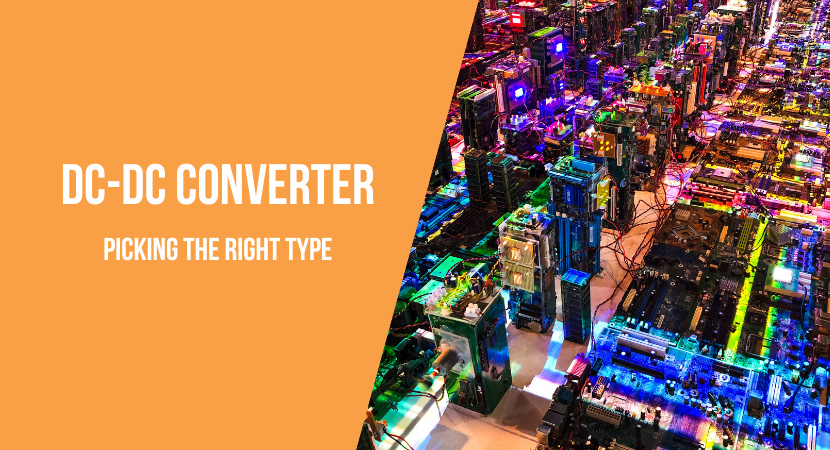
In the previous section, we explained the strengths and weaknesses of various DC-DC converters and how to use each one properly, but there are actually a variety of DC-DC converters on the market. When your company decides to make a purchase, it is important to be aware of the selection criteria in order to avoid being overwhelmed by the enormity of the purchase.
Let us now review the following five points to consider when choosing a DC-DC converter.
Five points to consider when choosing a DC-DC converter
Please refer to the information below after understanding the application required by your company.
Risk versus resource balance
If you simply buy something cheap, or if you only focus on safety, it’s possible you won’t be receiving the best converter for the job. Determine the safety required according to the usage environment, then understand the cost and select an insulated or non-insulated type.| Focus on safety | Focus on cost reduction | |
|---|---|---|
| Insulated type | ✓ | △ |
| Non-isolated type | △ | ✓ |
If safety and noise isolation are important, it is better to choose an isolated type. Isolated DC-DC converters use a transformer between input and output to provide electrical isolation. This ensures that you will not receive an electric shock if the input voltage and output voltage come into contact.
Isolated DC-DC converters are often used in medical equipment and portable devices such as smartphones and tablets, due to safety and noise countermeasures, as well as considering the impact on the human body.
If cost and size are important, a non-isolated type is a good choice. Non-isolated DC-DC converters do not use a transformer between input and output, so they are not electrically isolated. This makes it possible to achieve smaller size, lower costs, and higher efficiency.
In order to achieve smaller size and higher efficiency, non-isolated DC-DC converters are increasingly being used in in-vehicle equipment such as electric cars and hybrid cars.
Efficiency vs. noise balance
DC-DC converters can be divided into linear regulator type and switching regulator type, depending on whether the purpose is to emphasize efficiency or low noise.| Focus on efficiency | Focus on low noise | |
|---|---|---|
| Linear Regulator type |
✓ | △ |
| Switching Regulator type |
△ | ✓ |
Compared to linear regulator type DC-DC converters, switching regulator type DC-DC converters have a feature of high efficiency. This is because the switching action allows more of the input power to be converted into output power.
For example, switching regulator type DC-DC converters are often used in devices that require high efficiency, such as notebook computers and servers.
Compared to switching regulator type DC-DC converters, linear regulator type DC-DC converters have the characteristic of low noise. This is because no switching operation is performed, so no switching noise is generated.
For example, many noise-sensitive devices are used in audio equipment, wireless equipment, medical equipment, etc. Therefore, linear regulator type DC-DC converters are often used in these devices.
Input voltage
Variations in the input voltage change the stability of the output voltage.For example, as the input voltage decreases, the converter’s on-duty (the ratio of time the switching element is turned on) increases. If this on-duty changes, it will affect the output voltage stability due to the feedback circuit.
Efficiency and heat generation also change as input voltage changes.
For example, as the input voltage decreases, the current flowing through the switching element increases. The greater the current flowing through the switching element, the greater the loss in the switching element. This can cause reduced converter efficiency and increased heat generation.
Input range is often expressed as the ratio of maximum voltage to minimum voltage. Typical isolated DC-DC converters operate over a 2:1 or 4:1 input voltage range. Depending on the industry, industrial applications may require high input voltages (24V-72V), while small devices may require low input voltages (1V-5V).
Please check What is the expected input voltage of the products your company handles? Then, it is a good idea to consider which DC-DC converter can perform power conversion efficiently without compromising stability or converter lifespan.
Output voltage
Variations in the output voltage can affect the performance and reliability of the DC-DC converter. Output voltage fluctuations are mainly caused by input voltage fluctuations, load current fluctuations, switching noise, temperature changes, etc.A DC-DC converter converts current, but this conversion produces slight up and down waves in the output voltage. Ripple voltage is a sign that the electricity is not stable, and the larger this wave is, the more it will negatively affect the quality of the power supply.
On the other hand, the higher the output voltage, the smaller the output capacitance, which reduces the circuit mounting area and cost.
Depending on the design and application, the typical output voltage range for DC-DC converters used in consumer electronics, industrial equipment, automotive equipment, etc. is 1V to 24V. Certain industrial applications may require higher voltage outputs, such as 48V.
The type of DC-DC converter to consider will vary depending on how much output voltage is required and how much output stability and accuracy are required.
Output resistance
Output resistance is the load resistance value connected to the output side of the DC-DC converter. If the output resistance changes, converter performance such as output voltage, output current, and efficiency will change.If the output resistance is high, the output current will be small, which will reduce switching element loss and heat generation, improving lifespan and reliability, but as the output voltage approaches the input voltage, the step-down ratio will decrease. You may not be able to obtain the output voltage.
The output resistance range often ranges from about 10 milliohms (0.01 ohms) or less for high-performance devices to about 100 milliohms (0.1) or more for low-cost devices.
For example, precision measurement equipment and high-quality audio equipment require output voltage stability, making the output resistance value important.
In particular, check how much output you need in terms of conversion efficiency and stability. Conversely, it is important to check whether there are thresholds that must never be exceeded and to understand whether they are compatible with the DC-DC converter you are considering.
So far, we have identified five points to consider when choosing a DC-DC converter. In the next chapter, we will introduce a list of manufacturers that manufacture DC-DC converters. If you read the next chapter based on the general selection method introduced in this chapter, you will be able to determine which manufacturer is appropriate for your company.
5 recommended manufacturers of DC-DC converters
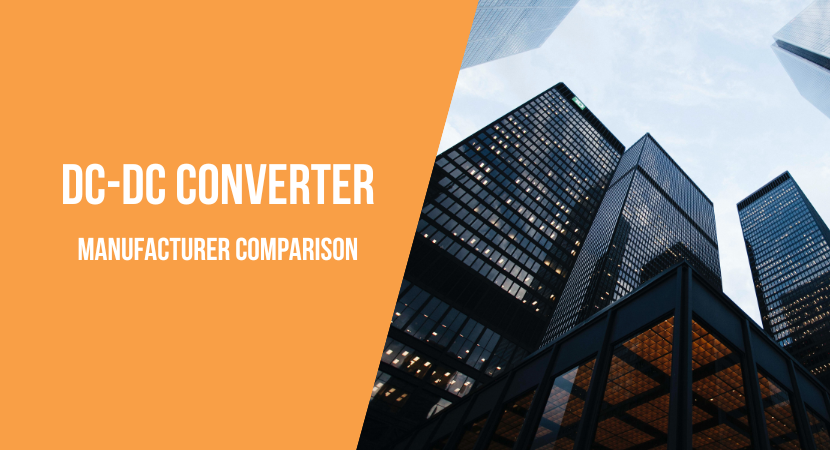
In the previous chapter, we introduced five points to consider when choosing a DC-DC converter. After sorting out your company’s installation requirements and checking the five points, it’s time to look for a company that actually manufactures DC-DC converters.
Here, we will introduce representative manufacturers of DC-DC converters. If there is a manufacturer you are interested in, please feel free to contact us.
Five representative manufacturers of DC-DC converters
Contact JET Global
RECOM Power
RECOM Power is a power supply manufacturer based in Austria and Germany, founded in 1974. They have extensive experience in developing and manufacturing the latest converter technology in the power range from 0.25W to 960W, and have a rich track record of use in low-volume, high-mix applications such as measurement, medical, and FA industries.RECOM Power mainly handles isolated DC-DC converters and non-isolated DC-DC converters. The non-isolated DC-DC converter boasts an efficiency of over 97%, and all products have received international safety certification. Their products are often used in the measurement equipment, medical, and FA industries.
They have the widest lineup on the market, including sizes, pin options, operating temperature ranges, and input/output voltage combinations from 1/4 Watt to 3 kW.
If you are having trouble making a selection and are looking for a non-isolated switching regulator DC-DC converter, we recommend checking RECOM Power’s DC-DC converter first.
Bellnix
Bellnix is a power supply manufacturer founded in 1978 and headquartered in Saitama City, Saitama Prefecture that develops products using advanced power supply technology. Their business is the development, manufacturing, and sale of power modules, power systems, wireless power supply products, and power supply related equipment.Bellnix mainly handles non-isolated DC-DC converters and isolated DC-DC converters. There are various types of isolated DC-DC converters, such as small size, low noise, high insulation, and high operating temperature range, that can meet a variety of needs. For example, they are delivered to industries such as medical, communications, defense, and aerospace.
Although there are many overseas companies, the key point of Bellnix is that it is headquartered in Japan. Another strength is that they consistently provide high quality, high performance, and highly reliable power products.
You can feel confident in selecting products from their lineup due to their long track record of dealing with the state of power supply infrastructure.. If you are looking for an isolated linear regulator DC-DC converter, please feel free to contact us.
MINMAX TECHNOLOGY
MINMAX TECHNOLOGY is a power module specialty manufacturer established in Taiwan in 1990. They offer a variety of power products such as DC-DC converters and AC-DC converters. They also offer products that comply with international standards globally and have distributors and support centers in each country.MINMAX TECHNOLOGY has introduced quality management systems such as ISO 9001 and ISO 14001, and also complies with environmental regulations such as RoHS and REACH, so they provide environmentally friendly products. Other key points to consider are that they have achieved miniaturization and high density using the latest technology, and that they also offer products at competitive prices.
MINMAX TECHNOLOGY has a wide variety of delivery records, especially in the railway industry. For example, it is compliant with railway EMC (EMI+EMS) standard EN 50121-3-2 and railway safety standard EN 50155 (IEC 60571) There are also packages that have obtained certification.
If your company is in the railway industry, MINMAX TECHNOLOGY is a must-see. In addition, They boast the world’s highest number of products and market share for non-isolated linear regulator DC-DC converters.
ROHM
ROHM is a Japanese electronic parts manufacturer founded in 1958 and headquartered in Kyoto. They offer products such as semiconductors, passive components, and LEDs. ROHM has advanced technological capabilities and a rich lineup in the field of DC-DC converters, and develops products that can be used in a variety of applications.ROHM is characterized by its handling of a variety of switching regulator type DC-DC converters. Examples include buck, boost, and buck-boost/inverting. There are also DC-DC converters with built-in FET and external FET types.
They handle DC-DC converters that have both high conversion efficiency and safety, and are compatible with small products by reducing the number of external components such as built-in FETs and reducing board space.
If your company uses small products, we recommend ROHM’s DC-DC converters, especially isolated switching regulator DC-DC converters.
TDK
TDK was founded in 1935 and is primarily engaged in the manufacturing and sales of electronic components. When the company was first established, it was called “Tokyo Denki Kagaku Kogyo Co., Ltd.” and engaged in the commercial production of ferrite magnets.After that, they began specializing in the manufacturing of electronic components, and currently handle magnetic-related products such as passive components such as capacitors and inductors, power supply devices such as AC adapters and DC-DC converters, and magnetic heads and magnetic sensors for hard disk drives.
DC-DC converters are available in both isolated and non-isolated types, and terminal shapes are compatible with various shapes such as DIP, SIP, and SMD.
They deliver to a variety of customers, including the information and communication technology industry, the automobile industry, and the energy industry, but TDK has an especially rich track record in the railway industry. Both rolling stock and ground equipment require DC-DC converters.
Examples of use include the ultra-compact DC-DC converter CCG series and the on-board type CC-E series. They are recommended for those seeking high safety.
If you are unsure which company to contact, please contact us.
Is this the right company or product for you? If you would like to know what product or manufacturer is best for you, please do not hesitate to reach out to us.We will analyse the differences between each product and company and suggest the company that best suits your purpose.
Contact JET Global

